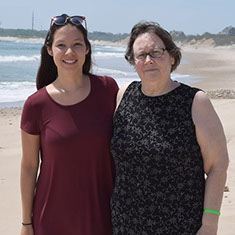When A Mother Decides To Stop Cancer Treatment And Face Death
By Dr. Annie Brewster and Leah Meyer
More than a decade ago, Colleen Lum was diagnosed with Stage 3 ovarian cancer. Her children, Kyle and Kiara, were 11 and 8 years old at the time.
A few months ago, after battling the disease for 13 years, Lum, who lives with her husband and family in Hopedale, Massachusetts, decided to end treatment. Today, at age 56, her health has further declined, according to her daughter. Lum is no longer eating or drinking much. And she's very, very tired.
Through it all, though, she's been clear-eyed about her illness.
"We’ve always been straightforward and honest," Lum said during an extensive interview in June. The kids "get the facts and the truth and it’s not 'Mommy has a tummy ache.' No, 'Mommy has cancer.' "
Lum added: “I was a good parent before cancer, but cancer made me a better parent, because you don’t have time to postpone.”
Listen to Lum and her daughter Kiara share their stories here:
Ovarian cancer is an insidious disease, often asymptomatic until it is quite advanced, resulting in five-year survival rates of under 50 percent. Lum has beaten the odds and navigated an onslaught of difficult decisions with resilience and a keen sense of her priorities.
"You can talk about sex and drugs and alcohol with your kids because you don’t have time to postpone those conversations," Lum said. "Nobody’s guaranteed tomorrow. And cancer makes that very relevant. When you can sit and talk to your children about your death, everything else becomes easy."
Four years ago, Lum refused to participate in a clinical trial that would have required her to spend several months away from home and apart from her kids. When her physician implored her to enter the trial, saying it was his job to keep her alive, she replied, “Well, it’s my job to be a mother.”
Lum knows that she won’t be around to see her 21-year-old daughter graduate from college — and it's the thought of missing those major life events that saddens her most. "It’s not the dying that upsets me," she said. "It’s the milestones in your children’s lives you’re gonna miss. Seeing them walk down the aisle or seeing them have babies."
Still, she's happy and proud she got to be a mother for so long. "My miracle isn’t that I walk out of here and I get cured. My miracle is that I got 13 years of a Stage 3C diagnosis and I watched an 8-year old and an 11-year old turn into a 21-year-old and a 24-year-old. The biggest thing here is perspective."
After years of intrusive treatment, harsh side effects and approximately 160 rounds of chemotherapy, Lum knew in April that it was time to stop. Her body had had enough. To those who insist she must keep fighting, she said: “So many people want to jump back into denial and pretend … that this isn’t happening. If you’re coming along for the ride, you’re getting in my boat, and my boat is reality.”
Now, with death approaching, Lum is grateful to know that not much has been left unsaid. And she spends time envisioning her death:
I hope I die with grace and dignity, which I probably will, and a few swear words. It’s one thing I’ve got as cancer’s gone on — I’ve maintained my filthy little mouth and my few favorite swear words. I wanna have the best quality of life for whatever days we have, and then it’s like, I don’t know what this whole dying stuff is gonna involve. I hope it’s not painful, I hope it’s peaceful. I hope I can die at home. But I don’t know what it looks like. If I got to call the shots, I’d get to hang around in bed and talk to the very last frickin’ minute. And kinda joke and go, 'Hey, it’s time to go.' And I say goodbye, and I’d walk out peacefully. But as with cancer and most things, I don’t know how much of a choice I get in that.
Lum wants to go out on her terms. “No ventilators or feeding tubes in this body,” she said. While she accepts that she may not be able to control many things that happen at this point, she wants to control the things she can, and she has spelled it out clearly for her family.
For instance: If she is in a coma, she says it's OK to send her to the hospital or hospice. She has chosen a casket, and wants it to be open. She's lined up a caterer for the reception.
In our society we are notoriously bad at talking about death. It wasn’t until this year that Medicare finally began reimbursing for end-of-life conversations between patient and doctor.
In one of the countless conversations Lum has had over the years, she imagines death as a continuation of life, but different: "What if [it's] nothing but two little hills, and there’s a bridge? And you’re just leaving one world to go to another … and it’s really something very simple?”
Dr. Annie Brewster, a Boston internist and founder of the Health Story Collaborative, is a regular contributor to CommonHealth. Leah Meyer is an intern with Health Story Collaborative and a student at Yale College.
Originally published on WBUR CommonHealth Blog on August 5th, 2016.


